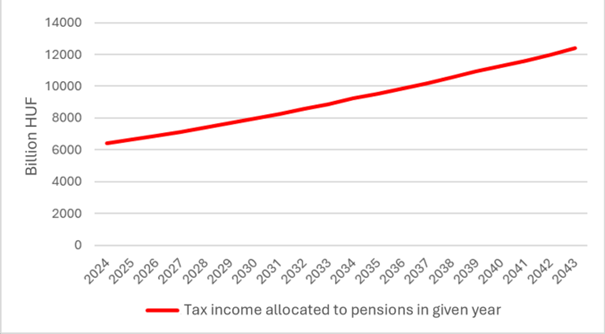Long-term demographic trends affect not only the working-age population but also future retirees. Currently, there are 1.998 million old-age pensioners in Hungary, and this number is expected to increase significantly in the coming years. How will this impact the sustainability of the pension system?
According to the Hungarian Central Statistical Office (KSH), life expectancy at birth was 71.4 years in 2000, rising to 76 years by 2022. The life expectancy at age 65 increased from 79.4 to 81.3 years. Currently, an old-age pensioner can expect to spend approximately 16 years in retirement. As public health improves over time (e.g., fewer people engage in physically demanding or unhealthy jobs), the life expectancy of those reaching retirement age may rise to 85 years.
Based on previous estimates by GKI, between 2024 and 2043, a maximum of 2.843 million people will retire in Hungary. If we assume a life expectancy of 85 years at age 65, this will result in a total pensioner population increase of 42%. However, pension expenditures will not only grow due to an increase in the number of retirees. The government adjusts pensions for inflation and occasionally pays pension premiums, leading to an estimated real pension increase of 1% per year. Additionally, the proportion of retirees with higher education is expected to rise, and these individuals generally earn higher wages, leading to higher pensions.
Projected Maximum Number of Retirees (in Thousands) for 2024-2043

(Source: KSH data, calculations by GKI)
Where Does Pension Funding Come From? The pension system is financed primarily from two sources: social security contributions (TB) and the social contribution tax (Szocho). In 2024, the budget law allocates 89.14% of the Szocho tax to the pension fund and 10.86% to the healthcare fund. Of the TB contributions, 54% goes to the pension fund, with the remainder largely supporting the healthcare system and a smaller portion allocated to the National Employment Fund. Essentially, increasing revenue for pensions would require either raising taxes and contributions or reallocating resources from other areas.
As of 2024, the pension system remains sustainable: planned pension expenditures amount to HUF 6,019 billion, while expected revenue from TB and Szocho contributions for pensions is projected to reach HUF 6,434 billion. However, by 2043, this balance will shift. While revenues are expected to nearly double to HUF 12,406 billion, expenditures will rise to HUF 14,786 billion.
Projected Pension Fund Revenue and Expenditure for 2024-2043 (Billion HUF)

(Source: GKI, own calculations)
Although current revenues cover pension expenditures, a shortfall of approximately HUF 230 billion is expected by 2043 under the existing regulations. This gap must be addressed. Within the pension system, solutions may include increasing the retirement age or raising TB and Szocho contributions. For example, a 0.15 percentage point annual increase in the Szocho tax rate or a 0.22 percentage point rise in TB contributions could bridge the deficit. Since total wage earnings are expected to nearly double, the central budget will also generate higher revenues through other taxes (e.g., personal income tax, VAT), allowing for greater financial support for elderly care.
Clearly, several measures can be taken to address the projected shortfall in a timely manner. By implementing gradual adjustments today, drastic policy changes can be avoided in the future.







